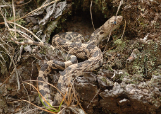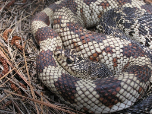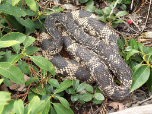Northern Pine Snake (Pituophis melanoleucus melanoleucus)
Description: Northern pine snakes are large, heavy-bodied snakes with a white, tan or yellowish background color and dark brown or black markings that begin as heavy mottling on the head and gradually become distinct blotches toward the tail. The belly is white or yellowish and may contain some light mottling of brown, orange or pink. They average about 4 to 5 feet in length; however, some specimens measure more than 6 feet in length.
Habitat: pine snakes require forest openings with drained, sandy soils for nesting and basking. Summer den sites are typically located in clearings near fallen logs. Winter hibernation refuges are located in nearby areas providing more vegetation cover and leaf litter. When active, they are usually found on the ground but may occasionally climb into low bushes or trees.
Range: The northern pine snake's range includes New Jersey, the western Appalachian mountains of Virginia, North Carolina, southern Kentucky, Tennessee, northern Alabama, northern Georgia, the piedmont area of southern North Carolina and nearly all of South Carolina. Throughout its range, this snake is nearly always associated with dry upland forests, most often with pine woods. It is also found in sandy, dry, coniferous forests.
Diet: Pine snakes eat rodents, other small mammals, birds and bird eggs. Young snakes eat small mammals, lizards and insects
Reproduction: Pine snakes reach sexual maturity at about 3 years old and will then breed once per year. Generally, breeding season begins in April and ends in May, but detailed information on breeding is limited to only a few subspecies. Males of various subspecies engage in combat during the breeding season, likely as a display of their dominance. Females dig a burrow in sandy soil, using their necks to scoop out the soil until they reach a layer with the right moisture content. The burrows are deep, sloping downard, then reising slightly and ending in a chamber where the female lays the eggs. Several females may use the same chamber.
They lay small clutches with about 8 eggs of relatively large size. Incubation typically lasts 51 to 100 days. There is no parental care once the young hatch. They are born in the middle of summer and typically emerge measuring 1.5 feet
Status: Listed as Least Concern in view of the fairly large range and number of subpopulations/locations and because it is unlikely to be declining fast enough to qualify for listing in a more threatened category.
»» Kingdom: Animalia - Animals
»» Phylum: Chordata - Chordates
»» Subphylum: Vertebrata - Vertebrates
»» Class: Reptilia - Reptiles
»» Order: Squamata - Scaled Reptiles
»» Suborder: Serpentes
»» Superfamily: Colubroidea
»» Family: Colubridae - Colubrids
»» Genus: Pituophis
»» Species: Pituophis melanoleucus - Pine Snakes
»» Subspecies: P.m. melanoleucus - Northern Pine Snake
This article uses material from the Wikipedia article "Pituophis melanoleucus", which is released under the Creative Commons Attribution-Share-Alike License 3.0. Content may have been omitted from the original, but no content has been changed or extended.
|








